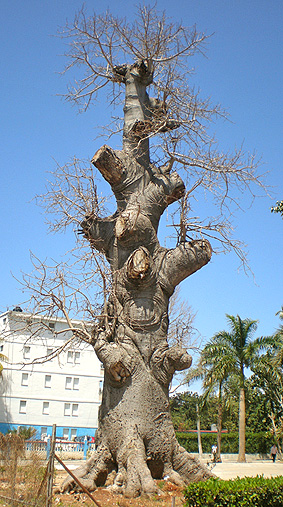Death of the Ceiba Tree
Isbel Diaz Torres

It’s now certain: my Ceiba tree has died. The tree that they pruned almost four years ago in my neighborhood was not able to survive that act of aggression. San Agustin, suburb of Havana, has been left without one of its principal cultural symbols.
Every year after that pruning I would see the Ceiba re-growing its shoots. I always prayed for it to have the power to hang on to life, but I knew that was impossible.
What’s more, I’m speaking of a gigantic tree; the Ceiba overshadowed the five-story buildings that surrounded it. Still today, with all of its foliage absent and its body partially consumed, it stands like a great obelisk, though now dead.
To produce the food to sustain such a floral mass required a tremendous quantity of leaves. You have to remember that these green parts of the plant transform light into chemical energy. In this resides the magic of plants. But the few buds that appeared every year could not satisfy the demands of the tree.

Moreover, the technique used in the pruning was incorrect, according to Isabel Russo, an official with the Ministry of Agriculture. Russo visited me at the beginning of 2007 and together we went to the park.
“Everything was a big mistake,” she confirmed, but the demands that I presented her as a simple neighbor resident were never satisfied. There was no apology made to the community, and there was no acknowledgement of the damage caused by the pruners.
Nor did the recently pruned Ceiba receive the phytosanitary treatment to prevent the proliferation of disease in its body. Its death was only a question of time.
All of the vigor that it embodied up until a short while ago gradually vanished. As a consequence, the devotees of the neighborhood have stopped placing offerings at the base of its trunk. The beautiful tree, the brother of the African Iroco, is now a shawdow of its past. Every year the danger of its falling will be greater, because the termites have already begun to wreak their havoc.
Meanwhile, I wonder if we can plant a new tree in its place, or will we also have to be witness of this dead giant’s slow and painful decomposition?






Lo siento Isbe!! Algo asi me temía pero no quería estropear tu esperanza de que finalmente volviese a ser el arbol que fue. Al menos ha servido para que esta voz de alerta, pueda en alguna medida impedir que estos desatinos sigan ocurrientos con nuestros arboles!!
Ojalá pueda ver muy pronto ese nuevo arbolito y a ti junto a él. Un abrazo bien grande!!
Angel
That’s really sad. New trees must be planted (maybe not the same type as in the ‘green’ picture it still looked unwell). The old tree could be given to a local artist to carve, still standing and then treated with preservative to slow the inevitable decay.
Lovely article. Such a beautiful tree to lose. Her wood should be used to carve a beautiful sculpture.